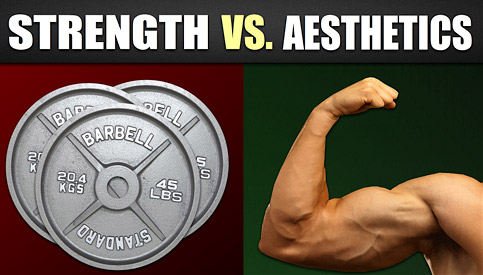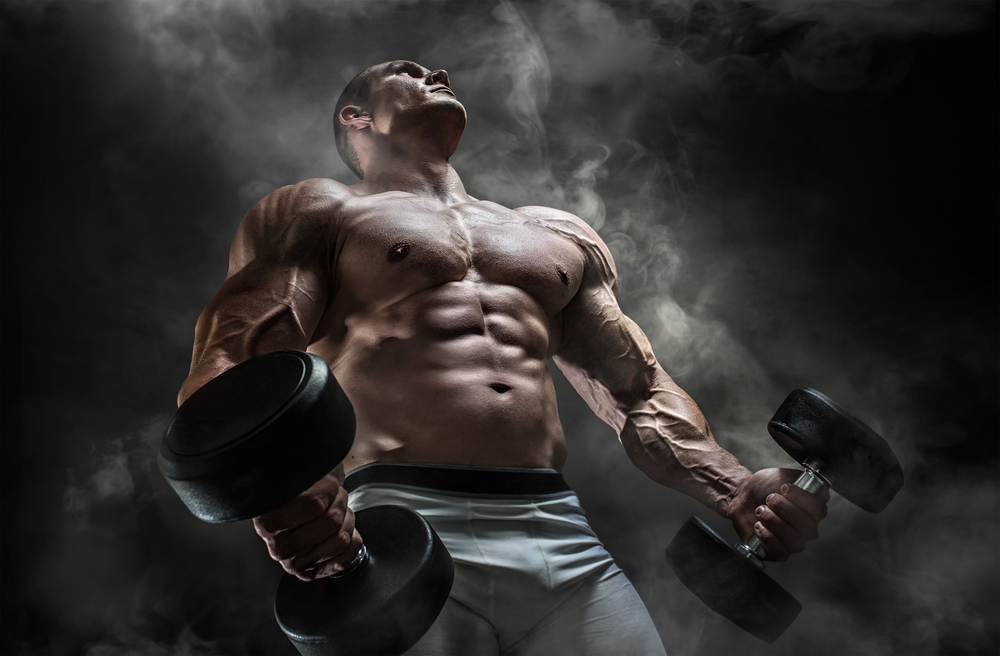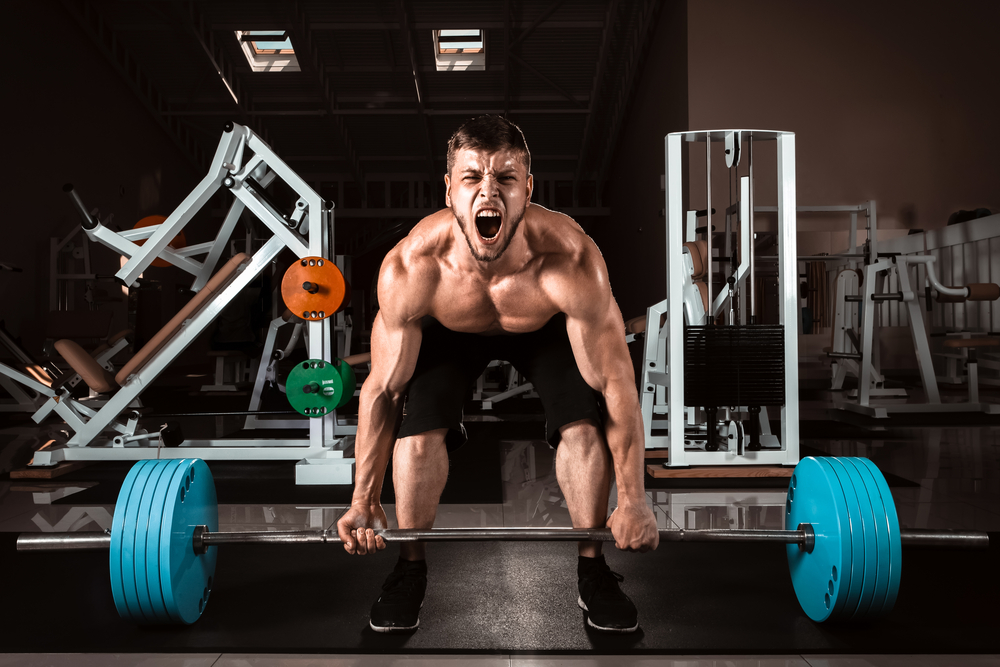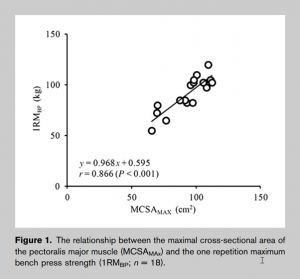TRAINING FOR STRENGTH VS AESTHETICS (WHICH IS BETTER?)

Strength vs. aesthetics: a true head-to-head bout.
While people often claim that training for strength is “superior” to training for hypertrophy or “aesthetics,” that’s a silly argument.
In this article, you’ll discover the three reasons strength training is not superior to training for body composition.
And, you’ll learn what focus would be best for your goals, situation, and preferences.
First, A Warning
Before we cover the three reasons strength training is not “superior” to hypertrophy training, let me make two things crystal clear.
The first point is that while it’s fine to train primarily for muscle growth and fat loss, it can be harmful to some people to get too wrapped up in their aesthetics.
Unless you’re a professional bodybuilder, it’s not a good thing to obsess over every ounce of muscle or every quarter percent of body fat you gain or lose. Doing so can be a source of stress and neuroticism if you take it to the extreme.
Thus, while it’s fine to train for aesthetics, don’t take it to an obsessive degree where you sport an excessively low body fat level that’s blatantly unhealthy or requires you to reach for illegal substances.
If you ever find yourself in that situation, you might want to change your perspective regarding your goals. Such an outlook is neither sustainable nor healthy.
Second, even if you train primarily for aesthetics, I still recommend you train your entire body equally and that you cover all the basic movement patterns.
So, don’t only train your “mirror muscles” like the chest and biceps. Instead, opt for a more balanced approach and include at least a bit of cardio each week for general health purposes.
Okay, with that said, let’s look at the three reasons why strength training is not superior to hypertrophy training or the other way around.
1. Training For Strength And Muscle Growth (Aesthetics) Go Hand-in-Hand

Contrary to what many people believe, strength and muscle growth aren’t mutually exclusive. Instead, they’re joined at the hip. That’s because progressive overload is the primary driver of muscle growth.
In other words, to add a lot of muscle to your frame, you’ll have to expose them to a stimulus they aren’t used to yet, which you can do most effectively by gradually increasing the resistance that you use.
Thus, by necessity, you’re going to have to get stronger. If you do that, you will build muscle. You simply don’t see guys with a huge bench but a small chest.
Consider this study published in The Journal of Strength and Conditioning Research. In it, researchers looked at the link between chest size and one rep max strength on the bench press.
They found that the more mass the subjects had on their pecs, the more weight they could bench press. There was a very close relation between the two, as you can see in the following image.
That isn’t a one-off study, either. Research also shows a strong relationship between body mass and performance in Olympic weightlifters.
And this relation is even more prominent in powerlifters, with a 0.86 to 0.95 correlation between fat-free mass and strength in the competition lifts. That’s close to a 100% correlation, which means fat-free mass and strength are more or less the same.
So, if you want to build muscle, focus on getting stronger by increasing the resistance over time, also known as progressive overload.
That’s why it makes no sense to claim that bodybuilders are not “functional” or that their bodies are “all show but no go.”
In reality, any natural lifter who’s been training for at least a couple of years and carries a decent amount of muscle will be stronger than the vast majority of the population.
The only people they might not beat when it comes to strength are powerlifters and Olympic weightlifters who solely focus on strength. But outside of that tiny niche, they’re still going to be in the very upper percentile strength-wise across the population.
And by the way, if you do want to learn how to optimize your workout program based on your situation and goals so that you can build muscle fast while making solid strength gains, take my physique quiz here. That’ll help you eliminate all the guesswork.
2. Beyond A Certain Point, There’s No Practical Need To Keep Getting Stronger

Sure, there are exceptions. Examples are if you’re a competitive powerlifter or athlete. Or, maybe you have some real-life day-to-day need that requires you to be extremely strong at a particular movement pattern (think labor-intensive jobs).
But these occasions aside, there’s no practical need to keep getting stronger once you’ve obtained a decent amount of strength.
So, training to be stronger than what you need for daily life isn’t much different from training to increase muscle growth in that both are ego-driven goals.
That’s why there’s nothing better or morally superior about one or the other. Both ultimately come from the same place.
In fact, you can even make the argument that in the long run, bodybuilders end up being more functional than most powerlifters.
The reason is that many people who are constantly trying to push the envelope and become as strong as physically possible end up hurting themselves.
So, the person who’s fairly strong but still keeps things a bit more on the moderate side might actually end up with healthier joints and connective tissue 10, 20, and even 30 years down the line.
I’m not saying that this is always the case. But many powerlifters do indeed end up injured or have to scale back, which can detract from overall functionality and performance in the long-run.
3. Why Stop At The Powerlifts If Strength And Functionality Truly Are The Superior Goal?

I mean, why stop at seeing how much weight you can lift in a low to moderate rep range? Because ultimately, if you’re talking about overall fitness and functionality, maximum strength only represents a fraction of all the ways you could train for that goal.
For example, you might be able to squat 600 pounds but are out of breath after doing ten minutes of cardio.
And what about other weightlifting movements outside of the big three? Why would a deadlift be more valuable than a clean and jerk? Or why would a squat be more valuable than a lunge?
And what about calisthenics, sprinting, long-distance running, jumping, swimming, climbing, and throwing? There are many ways to train for “performance.”
No one is going to be able to train and excel at every single one of them. That’s why there’s no specific reason to glorify the ability to lift a heavy barbell for one rep.
Don’t be too close-minded. Instead, determine your goal and decide what would be the best way to train for it.
If your sole goal is to become as strong as possible on the squat, bench press, and deadlift, then by all means, structure your workout program revolve around those movements.
But if you truly want to train for functionality, make sure your workout program is multi-dimensional by including a wide variety of training aspects.
Examples are powerlifting movements and accessories, the Olympic lifts, doing sprints, adding jumping exercises, including some “traditional” bodybuilding work, and performing at least some cardio every week.
Training For Strength Vs. Aesthetics: The Bottom Line
To sum it all up, I don’t see a reason to claim that training for maximum strength is a better goal than training for maximum muscle growth or overall aesthetics. That’s because:
- Strength and muscle growth largely go hand in hand. If you want to gain muscle, you’ll have to focus on getting stronger as that’s what drives growth.
- By training for muscle growth or overall aesthetics, you’ll still have all the strength you need to function optimally in real life (assuming you’re not an athlete or someone who needs to be very strong at a particular movement pattern for some reason).
- There are countless ways to train for physical performance beyond just lifting heavy objects. There’s no particular reason to glorify that one subset of performance training above other methods.
It all comes down to identifying what you want to accomplish based on your personal situation, goals, and preferences.
You can then look at what will be the best way to get there, which, for most people, includes a balanced gym program instead of focusing on one single aspect.
If you found this article helpful, make sure to sign up for your FREE custom fitness plan below...





